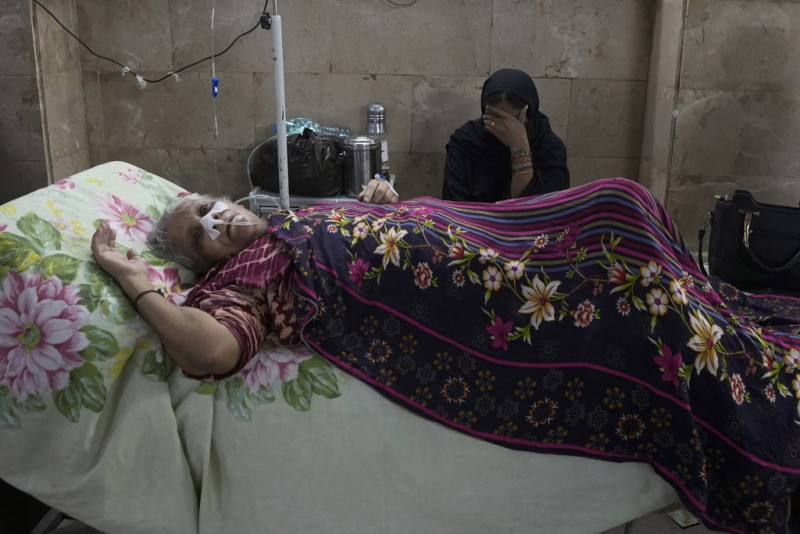It’s like living in the death valley, the warmest and most dry place in North America, where temperatures rise to similar levels
One nightmare is experienced by hundreds of thousands of people in India and Pakistan due to early summer heat arrival that tests the limits of survival and exerts tremendous pressure on energy reserves, crops and means of living.
Both countries face heatwaves during the summer months May and June, but this year’s heat season has arrived earlier than usual and is projected to last longer.
Temperatures are expected to rise to dangerous levels in both countries this week.
In parts of Pakistan, it is likely that there will be a heat of up to 8 degrees Celsius above normal between April 14 and 18, according to the country’s meteorological department. Maximum temperatures in Baluchistan, southwest of the country, could reach up to 49 degrees Celsius (120 Fahrenheit).
It’s like living in the death valley – the hottest and dryer place in North America – where temperatures during the summer often rise to similar levels.
Inhabitants describe the “hell” heat
THE Ayoub khosawho lives in the city of Dera Murad Jamali in Baluchistan, said that the heat arrived with a “tension that surprised many”, creating serious challenges for its residents.
“One of the most important issues is persistent power outages“, Said Khosa, who explained to CNN that it could take up to 16 hours a day.
“This has exacerbated the impact of the heat, making it harder for people to cope with. “he said.
OR neighboring IndiaIt is also experiencing excessive heat that arrived earlier than usual, and meteorologists warned people in areas of the country to prepare for a “over the usual number of heatwaves” in April.
The maximum temperatures in the capital Delhi, a city of over 16 million residents, have already exceeded 40 degrees Celsius (104 Fahrenheit) at least three times this month – up to 5 degrees above the seasonal average – the meteorological service said.
Terrible heat is also addressed in many neighboring cities, including Rajastan in the northwest, where workers and farmers are struggling to cope and reports of diseases are beginning to appear.
Maximum registered temperatures in Ratzastan areas reached 44 degrees Celsius (111 Fahrenheit) on Monday, according to the meteorological department.
OR Anita soniBy the women’s team Thar Mahila Sansthan, he said that the heat is much worse than other years and is worried about how it will affect children and women in the state.
When workers or farmers go out, there is a momentary lack of drinking water, people often feel they vomit, get sick or feel dizzy, he said.
THE farmer Balu Lal He said that people are already getting sick because of work in heatwave. “We can’t even afford to work under these conditions“, He said. “When I am out I feel that people will burn because of the heat ».
Lal said he was worried about his job and how to make money for his family. “We don’t have where else to go“, He said.
Survival limits are tested
Experts claim that rising temperatures test human limits.
Excessive heat has led to death tens of thousands of people in India and Pakistan in recent decades, and climate experts have warned that by 2050 India will be among the first parts where temperatures will exceed survival limits.
Under heatwave, pregnant women and their unborn children are particularly at risk. ‘gets unexplained miscarriages and births of early baby“, Said Neha Mankani, a consultant to the International Confederation of Midwifery in Karachi.
“In summers, 80% of babies are born prematurely with respiratory problems due to weather conditions. We also see an increase in hypertension caused by pregnancy (which could) lead to preeclampsia – the main cause of maternal mortality“
India and Pakistan, both countries with strong development inequalities, are expected to be among countries that have been more affected by the climate crisis – with more than 1 billion people to be predicted to be affected by subcontinent.
Possible consequences range from lack of food and drought to floods from ice melting, according to Mehrunissa Malik, a climate change and sustainability specialist from the capital of Pakistan Islamabad.
Source: Skai
I have worked as a journalist for over 10 years, and my work has been featured on many different news websites. I am also an author, and my work has been published in several books. I specialize in opinion writing, and I often write about current events and controversial topics. I am a very well-rounded writer, and I have a lot of experience in different areas of journalism. I am a very hard worker, and I am always willing to put in the extra effort to get the job done.











